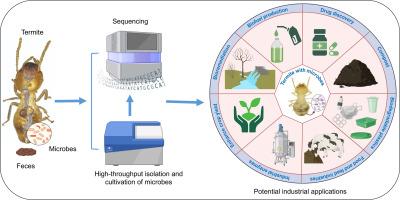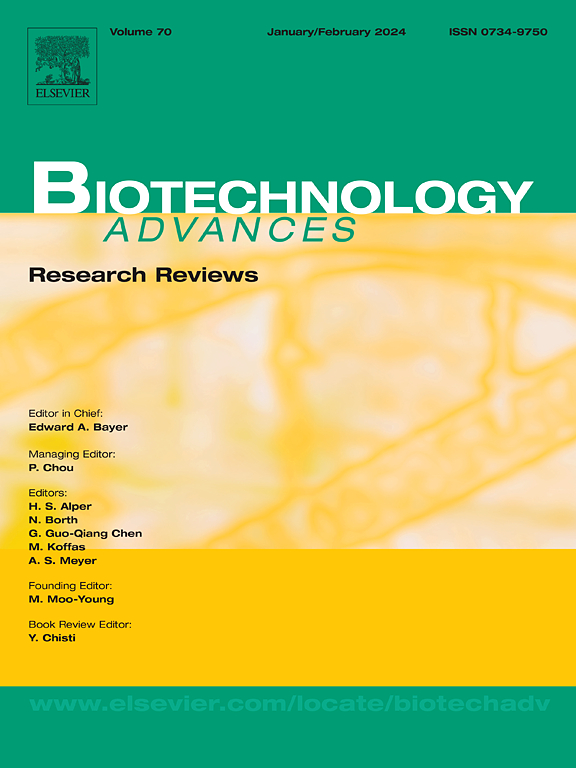推进从白蚁肠道中培养工业和生态相关微生物的方法。
IF 12.5
1区 工程技术
Q1 BIOTECHNOLOGY & APPLIED MICROBIOLOGY
引用次数: 0
摘要
白蚁的肠道窝藏着一个非常密集和多样化的共生微生物联合体,包括古细菌、细菌和真核生物分类群。这些共生群落具有复杂的生态过程,在多个领域具有明显的开发潜力,包括工业上重要的酶、生物燃料、制药和生物修复。尽管白蚁肠道的微生物种类丰富,但仍有相当一部分微生物群落未被发现,也没有得到充分的表征。尽管传统的基于培养和不依赖于培养的基于分子的技术被广泛用于研究白蚁肠道微生物群,但它们在分离、培养和表征不太普遍的微生物谱系方面经常遇到限制,并且偏向于某些分类群。分子技术的快速发展极大地促进了白蚁肠道微生物的鉴定和基因组潜力,揭示了隐藏的多样性和应用潜力。然而,基于基因组见解的培养方法的局限性阻碍了我们对大多数这些微生物生态学的理解以及对其特性的资本化。为了帮助改善白蚁肠道微生物的培养方法,我们概述了过去和新兴的共生微生物的分离和培养方法。在此过程中,我们强调了未来的方向和当前需要克服的挑战,以推进这些方法。本文章由计算机程序翻译,如有差异,请以英文原文为准。

Advancing approaches to cultivate industrially and ecologically relevant microorganisms from termite guts
The termite gut harbours a remarkably dense and diverse consortium of symbiotic microbes, encompassing archaeal, bacterial, and eukaryotic taxa. These symbiotic communities hold intricate ecological processes and a pronounced potential for exploitation across multifaceted domains, including industrially important enzymes, biofuels, pharmaceuticals, and bioremediation. Despite the conspicuous richness, a substantial portion of microbial assemblages inhabiting the termite gut remains undiscovered and inadequately characterized. Although traditional culture-based and culture-independent molecular-based technologies are broadly used to study termite gut microbiota, they more recent frequently encounter limitations in the isolation, culturing, and characterization of less prevalent microbial lineages and are biased toward certain taxa. The rapid development of molecular techniques has greatly promoted the identification and genomic potential of microbes in termite guts, revealing hidden diversity and application potential. However, limitations in culture-based approaches to build on genomic insights have hampered our understanding of the ecology of most of these microbes and the capitalisation on their properties. To help improve culturomics approaches for termite gut microbes, we provide an overview of past and emerging methodologies for isolation and cultivation of symbiotic microbes. In doing so, we highlight future directions and current challenges that need to be overcome to advance these approaches.
求助全文
通过发布文献求助,成功后即可免费获取论文全文。
去求助
来源期刊

Biotechnology advances
工程技术-生物工程与应用微生物
CiteScore
25.50
自引率
2.50%
发文量
167
审稿时长
37 days
期刊介绍:
Biotechnology Advances is a comprehensive review journal that covers all aspects of the multidisciplinary field of biotechnology. The journal focuses on biotechnology principles and their applications in various industries, agriculture, medicine, environmental concerns, and regulatory issues. It publishes authoritative articles that highlight current developments and future trends in the field of biotechnology. The journal invites submissions of manuscripts that are relevant and appropriate. It targets a wide audience, including scientists, engineers, students, instructors, researchers, practitioners, managers, governments, and other stakeholders in the field. Additionally, special issues are published based on selected presentations from recent relevant conferences in collaboration with the organizations hosting those conferences.
 求助内容:
求助内容: 应助结果提醒方式:
应助结果提醒方式:


